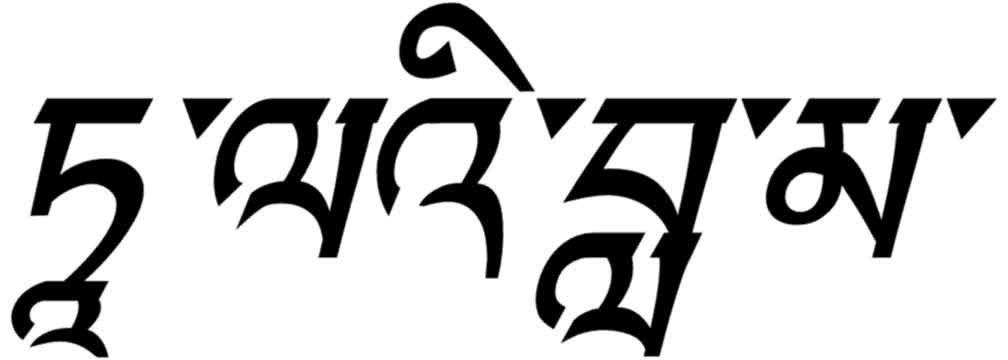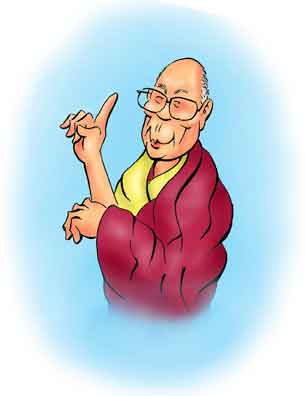


Again the author and illustrator of CooperToons hopes to ameliorate the well-intentioned but nevertheless misguided criticism that he harbors indifference, lack of respect, and disdain for  Family Values. And certainly the best way to achieve said exoneration is to feature a tribute to His Holiness.
Family Values. And certainly the best way to achieve said exoneration is to feature a tribute to His Holiness.
His Holiness, the Dalai Lama, that is. Tenzin Gyatso was born Lhamo Thondup in Tibet in 1935 and became the Dalai Lama (the 14th) in 1950. This, though, was a difficult time to be a religious leader as the up-and-coming ideology of the hip and cool was Marxism. Although it's not really true that Marx wanted to abolish all religions by force, he did think they would ultimately be replaced by the Philosophy of Dialectal Materialism, whatever that is.
But the immediate problem for the new and youthful Dalai Lama was that once Mao Tse-Tung (as his name was spelled back then) took over in 1949, China also laid claim to Tibet. Although the Dalai Lama managed to hang on in Lhasa for a decade, in 1959 he was forced to flee. The Indian Prime Minister, Jawaharlal Nehru, had no objection to him setting up a government in exile. So things have remained ever since.
There are of course different denominations (for want of a better word) of Buddhism. There are the three main branches known as Theravada, Mahāyāna, and Vajrayana. Tibetan Buddhism is classified as being part of Vajrayana and the spiritual leader of Tibetan Buddhism is of course the Dalai Lama ( ). The Dalai Lama himself, though, maintains he is a simple monk and claims no special wisdom. Wisdom is what each individual must find for themselves.
). The Dalai Lama himself, though, maintains he is a simple monk and claims no special wisdom. Wisdom is what each individual must find for themselves.
As to what Buddhist beliefs actually are, many born into Western culture find them incomprehensibly vague. But if you think things are simple and straightforward in the Western religions and philosophies, just get a Catholic and a Lutheran together in the same room. At present there are about 30,000 individual Christian denominations and the number doesn't seem to be shrinking.
For Westerners the primary difficulty with Buddhism is that it doesn't really meet the expected model. For one thing, in Buddhism there are what Westerners will call the Buddhist "Bible", and books with titles like Buddhists Scriptures can be found in various editions. However, these are not doctrinal texts that are collected into a single and sacred text. A somewhat surprising consequence is that in Buddhism there cannot really be any such thing as heresy.
At this point the reader may object. After all, look at the news stories about "heretical" Buddhists. See? Even Buddhists say there are heretics to their doctrine.
Well, not really. These stories are inevitably written for the Western audiences and using terms their audience will understand. Instead as an example of the difference between Buddhism and Western religions, it's best to go to the top and read what the Dalai Lama himself had said:
Suppose that something is definitely proven through scientific investigation, that a certain hypothesis is verified or a certain fact emerges as a result of scientific investigation. And suppose, furthermore, that that fact is incompatible with Buddhist theory. There is no doubt that we must accept the result of the scientific research.
If science proves some belief of Buddhism wrong, then Buddhism will have to change.
Such statements, believe it or not, are quite compatible with what Siddhārtha Gautama, later known as Gautama Buddha, himself said. He said that questions regarding when the Earth was created, how things came into being, how old is the Universe, and such stuff were not things for the religious to get overly concerned with. There were plenty of other things to think about.
Now a lot of people go into spittle-flinging diatribes and say you have to have a concept of absolute teachings regardless of what science discovers. If you don't, then you just don't have a religion.
Besides without the concept of heresy how could you handle people like Giordano Bruno who was burned at the stake in 1593 for believing there might be life on other planets?
Or what about Anne Askew, the Protestant preacher who was tortured and executed by Henry VIII for saying that the wine and bread used in Communion was just wine and bread? (Psst! Henry never considered himself a Protestant.)
And then you have someone like the Spanish teacher Cayetano Ripoll who introduced his school students to Deism and who in 1826 became the last person to be executed by the order of the Spanish Inquisition.
Now for those who think these last comments are a bit snarky, there are a few practitioners of Western religions such as the Trappist (Roman Catholic) Monk, Fr. Thomas Merton who don't believe that there is as much conflict with East and West as many may think. Tom himself took a lot of interest in the Japanese form of Buddhism known as Zen which is part of Mahāyāna. And Tom - not only a monk but also an ordained priest, mind you - said:
I think if Catholics had a little more Zen they'd be a lot less ridiculous than they are.
Of course, Tom's remark was obviously tongue-in-cheek. And today Tom is indeed praised at the highest level of the Roman Catholic Church (and we mean the highest level). Nevertheless you'll also find there are Church officials who are distinctly ill at ease with his philosophy. Some have even worried that he might have become a secret Buddhist. So it's not surprising that a well-known Catholic scholar recently divvied up the list of Tom's many books into one group that are recommended reading and another group that must be read "with caution". Tom's later ideas, he concluded, could be confusing and some are - direct - quote - "dangerous".
Today in  , most ministers disagree that you can blend East and West religions and they tend not to share Tom's easy-going attitude. Once a preacher in a Quaint Town in the America's Historical West was speaking to some of his youth group. He was talking about why their religion was the best. Why, not only did Buddhists think that it was the highest of spirituality to be nothing at all - which he said Buddhists called nirvana - but according to Buddha the world just came out of nowhere and then shrank and contracted and then expanded and the animals and people appeared.
, most ministers disagree that you can blend East and West religions and they tend not to share Tom's easy-going attitude. Once a preacher in a Quaint Town in the America's Historical West was speaking to some of his youth group. He was talking about why their religion was the best. Why, not only did Buddhists think that it was the highest of spirituality to be nothing at all - which he said Buddhists called nirvana - but according to Buddha the world just came out of nowhere and then shrank and contracted and then expanded and the animals and people appeared.
Huh! How ridiculous! How absurd!
Then he told the kids about the two naked people running around in a garden and a snake that talks.
References
"The Dalai Lama: The role of the Dalai Lama", Religions, BBC News, September 21, 2006
"Is Buddhism the Most Science-Friendly Religion?", David Barash, Scientific American, February 11, 2014.
"Our Faith in Science", Tenzin Gyatsonov [The Dalai Lama], The New York TimesNovember 12, 2005.
Buddha: His Life and Teachings, Jeanyee Wong (Illustrator), Peter Pauper Press, 2006.
"Thomas Merton and Dialogue with Buddhism", John Coleman, America: The Jesuit Review, July 13, 2012.
"Can You Trust Thomas Merton?", Anthony Clark, Catholic Answers, May 1, 2008.
"What to Make of Thomas Merton?", Susan Brinkmann, Women of Grace, February 8, 2016.
The Spanish Inquisition: A History, Joseph Pérez (Author), Janet Lloyd (Translator), Yale University Press, 2005.
Daily Life During the Spanish Inquisition, James Maxwell Anderson, Greenwood Press, 2002.